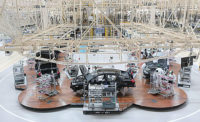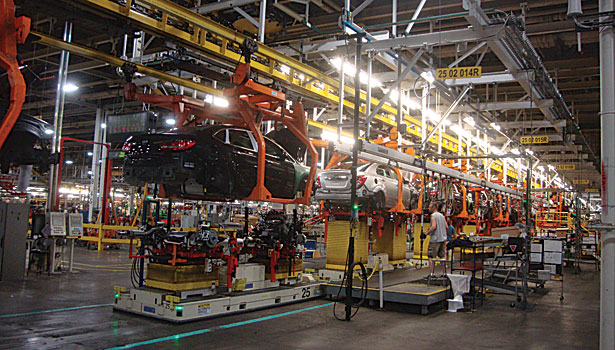GM Rethinks Line-Side Parts Delivery

General Motors recently invested more than $500 million to revamp the Orion Assembly Plant and turn it into a showcase for flexible manufacturing. Photo courtesy General Motor Co.

Parts and components are sequenced offline by third parties and delivered line-side on kit carts. Photo by Austin Weber

Automated guided vehicles enable flexible material handling in the Orion plant. Photo courtesy General Motor Co.

Kit carts ride on skillet conveyors, allowing operators to assemble the front and rear ends of two different vehicles. Photo by Austin Weber

Unlike typical automotive plants, the sides of the Orion assembly line are not cluttered with rows of part bins. Photo by Austin Weber





Extreme Makeover Home Edition” was a popular reality TV show in which an old house gets transformed in a matter of hours. If a similar show existed for factories, an automotive assembly plant in Lake Orion, MI, would be a good candidate.
Article Index:
General Motors recently invested more than $500 million to revamp the facility and turn it into a showcase for lean material handling. Production lines were reworked, creating more space to house material onsite that once took up valuable space on the line.
The new approach reduces the overall environmental impact of the plant’s material handling systems. It also provides significant cost savings to GM’s small-car program. In addition, flexible manufacturing systems allow the 31-year-old plant to quickly respond to changes in market demand.
The 4-million-square-foot Orion Assembly Plant, which is home to the Chevrolet Sonic subcompact and the Buick Verano compact sedan, is also unique because of its groundbreaking labor contract. GM reshored production of the Sonic from South Korea after the United Auto Workers (UAW) union agreed to implement a competitive operating agreement, which included an innovative staffing plan to reduce cost.
But, five years ago, things were much different. The Orion facility was slated for closure. It was among a group of several factories that GM planned to shutter during its bankruptcy. However, in June 2009, the automaker announced that the Orion plant would be retooled to build a next-generation small car for Chevrolet.
General Motors worked closely with the UAW to create an innovative labor contract that allows the Orion plant to be flexible and lean. That’s an essential ingredient to long-term success in the highly competitive small-car segment.
After the last Chevrolet Malibu and Pontiac G6 midsize sedans rolled off the line in 2009, the Orion plant was closed for an 18-month makeover. In October 2011, President Barack Obama visited the factory along with South Korean President Lee Myung-bak and proclaimed it to be a shining example of the landmark U.S.-South Korean Free Trade Agreement.
Today, the Orion plant boasts the most compressed GM manufacturing footprint in North America. The body shop, paint shop and final assembly area have been reduced to 2 million square feet (the remaining space in the building is now used by third-party suppliers).
During the renovation, most of the conveyors were removed. In fact, the only conveyor system recommissioned from the old plant is the one that runs the chassis line. The paint shop was completely gutted and rebuilt with environmentally friendly equipment.
The footprint of the body shop was reduced from more than 1 million square feet to 470,000 square feet. It now features state-of-the-art robots and automated guided carts (AGCs). Automated guided vehicles (AGVs) are used in the chassis department.
“AGVs and AGCs give us the flexibility to move production to virtually anywhere that we want,” says Jim Bumgardner, business manager for materials at General Motors. “AGCs are used in the body shop to transport front-end and rear-end modules. They also deliver instrument panels to the trim line. AGVs transport engines, rear suspensions and exhaust systems to the chassis line.”
During the renovation, the layout of the general assembly area also changed dramatically. The trim line used to run from east to west; it now runs from north to south.
Third-Party Suppliers
The Orion complex currently employs around 1,550 hourly workers, 880 traditional workers, 670 entry level workers and 500 others employed by third-party parts suppliers. Several third-party suppliers handle logistics at the plant as part of the efforts to hold down costs. Having suppliers located in-house saves GM approximately $10 million annually in shipping.
“The lines of demarcation are very blurred,” says Bumgardner. “You can’t tell who’s who within the plant—there’s no designation between GM employees and third-party employees. We all have one vision and one purpose, which is to function as one team to build a small car at a profit in Michigan.
“Our partners receive the same training and quality of work life,” adds Bumgardner. “They are not looked upon differently from a traditional GM employee, and they aren’t segregated on the plant floor. They’re also expected to adhere to all our health and safety standards. “
Innovative material handling is key to building small cars competitively in the United States. “We wanted to prove everyone wrong and show that we can build a small car in Michigan at a profit,” says Bumgardner.
But, that wasn’t always the case back in the old days, when parts bins and bulky racks typically surrounded automotive assembly lines. Forklifts constantly fed parts to the line and operators wasted much of their time walking back and forth.
When GM engineers revamped the Orion Assembly Plant, they focused on innovative material handling processes that would minimize work paths, eliminate waste and excessive movement, reduce ergonomic risks and improve operator efficiency.
“Line-side delivery has changed markedly over the past 20 years at General Motors plants,” says Bob Fox, Ph.D., GM technical fellow for ergonomics who supports the work of the joint ergonomics teams at Orion and other GM plants. “We are not the bulk-delivery, large line-side footprint manufacturer that we used to be.
“We have steadily moved away from fork truck delivery of materials to the line and have gone to tugger-delivered small lots for smaller parts and dolly-delivery for larger and sequenced parts,” Fox points out.
“We are also moving to the next phase of material delivery, which consists of kits of parts assembled and delivered to line operators that have all the parts needed for one job cycle,” adds Fox. “This is part of our lean material strategies to further reduce line-side material footprints and improve quality and ergonomics.”
Flexible Assembly
The Chevrolet Sonic is the only subcompact built in the United States. It’s available in hatchback and four-door models and competes against entry-level vehicles such as the Honda Fit, Hyundai Accent and Toyota Yaris.
However, one out of every three vehicles on the Orion assembly line is a Buick Verano, which requires more parts than the Sonic. Among other features, it includes 10 standard air bags, an available heated steering wheel and a next-generation radio system with OnStar-powered connectivity.
The Orion plant is the first GM facility in North America to house most of its inventory within the four walls of the factory. “Third-parties do all kitting in-house, except for seats and fascias, which come in sequenced from the supplier,” Bumgardner points out.
Reducing the line-side footprint makes it easier for operators to get parts and reduces the amount of money that’s tied up in inventory. Small-lot delivery is one of the keys to the success of the Orion plant.
“Small-lot delivery uses central material areas (CMAs),” explains Fox. “Operators have enough material line-side for only two to four hours.
“There aren’t any big containers sitting there that the operator has to dive into,” adds Fox. “This reduces the amount of in-process material that we have tied up in the plant. Years ago, automotive plants were as much warehouses as they were manufacturing operations.”
The Orion plant’s CMA, which is managed by a third party, contains small-lot quantities of parts, such as nuts and bolts, that are packed in totes and cardboard boxes on pallets that would take up a tremendous amount of space line-side. There are roughly 1,800 different part numbers handled by the CMA.
“Third-parties sequence the parts and deliver them in small quantities, based on hourly usage, to the assembly line,” says Bumgardner. “We run an average of eight different routes every hour out of the CMA to the production line.
“If the market demands more of the Sonic mix and less Veranos, we can change within eight hours to switch our model mix,” explains Bumgardner. “Having the CMA and controlling inventory in-house allows us to change model mix with minimal impact. It’s just a matter of sending schedules back to the suppliers in-house to adjust parts sequencing.
“The plant’s compressed footprint allows us to keep operators in fixed positions,” adds Bumgardner. “In our lean material focus, the operator is a surgeon. Our job in materials is to hand them the tools they need to perform their operation.
“They are 100 percent focused on their operation,” Bumgardner points out. “They’re not looking for different bins, reading manifests or searching for different part numbers. Everything they need is either kitted or sequenced to them line-side. That way, they are able stay within their footprint and perform their operation.”
There is minimal over-speed built into the Orion conveyor system,which traditionally provides a buffer in between the body shop, paint shop and final assembly line. “That prevents us from overproducing, which is waste,” says Bumgardner. “We run the leanest manufacturing system in General Motors North America.”
The Orion plant is also a showcase for GM’s world-class kitting operation. “Kits of parts and components are made up off-line and delivered to operators on carts,” says Fox. “This minimizes our material footprint. But, it also has quality benefits, because operators are given just the parts that they need for their build. The risk of putting on the wrong parts is greatly minimized.”
A minomi (parts without a container) delivery system is used on the trim line for more than 40 different part numbers, such as headliners, wiring harnesses and taillamps.
“Instead of having stock line-side, we sequence it into a rack, tow it line-side with a tugger, and present it to the operator,” says Bumgardner. “Kit carts are rolled up a ramp onto the skillet conveyor between vehicles and locked in place. Operators scan the manifest on the cart against the manifest on the vehicle to ensure that the right kit is going to the right car.”
Each kit cart contains enough parts to build several different vehicles. The front section of the cart builds the rear end of each car. The back end of the cart contains parts necessary to assemble the front end of the next vehicle on the line.
“The uniqueness of the kit cart is that it can build two different vehicles, front or rear,” says Bumgardner. The cart is manually pushed through the offline sequencing cells by third-party operators who scan the parts to ensure that they are picking the right item. A pick-to-light system is used to error-proof the process.
Looking for a reprint of this article?
From high-res PDFs to custom plaques, order your copy today!










